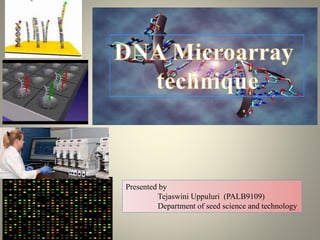
Microarray technique
- 1. Presented by Tejaswini Uppuluri (PALB9109) Department of seed science and technology
- 4. A DNA microarray (also commonly known as DNA Chip or biochip) is a collection of microscopic DNA spots attached to a solid surface. Each DNA spot contains picomoles (10−12 moles) of a specific DNA sequence, known as probes (or oligos). Each known gene or “probe” occupies a particular “spot” on the chip, and varying levels of fluorescent activity show varying levels of gene activity in introduced genetic material. Fluorescently labeled target sequences that bind to a probe sequence generate a signal.
- 5. Historical background : Evolved from southern blotting The concept of DNA microarrays began in the mid 1980s. • Pin based robotic system was developed by Lehrach’s group in 1990. •“Quantitative Monitoring of Gene Expression Patterns with a complementary DNA microarray” reported by Patrick Brown, Mark Schena and colleagues in Science (1995). • Steve Fodor developed scanner for reading the output. • Mark schena was proclaimed as the “Father of Microarray Technology”. Steve Fodor Mark schenaPatrick Brown • • •
- 6. • 1991 - Photolithographic printing (Affymetrix) • 1994 - First cDNA collections are developed at Stanford. • 1996 - Commercialization of arrays (Affymetrix) • 1997- Genome-wide expression monitoring in S. cerevisiae (yeast) • 2003 - Introduction to clinical practice • 2004-Whole human genome on one microarray Singh, A., & Kumar, N. (2013). A review on DNA microarray Technology. International Journal of Current Research and Review, 5(22), 01-05.
- 7. The core principle behind microarrays is hybridization. Samples are labelled using fluorescent dyes. At least two samples are hybridized to chip. Complementary nucleic acid sequences get pair via hydrogen bonds. Washing off of non-specific bonding sequences . Sample Preparation and labelling Hybridisation Washing Image acquisition and data analysis
- 8. There are 2 types of DNA Chips/Microarrays: 1. cDNA based microarray (or) Spotted DNA arrays 2. Oligonucleotide based microarray
- 9. There are certain requirements for designing a DNA microarray system viz.,: 1. DNA Chip 2. Target sample (Fluorescently labelled) 3. Fluorescent dyes 4. Probes 5. Scanner
- 10. Various types of cells in body are different from one another due to different genes being “turned on” and “turned off”. Because of differ in GENE EXPRESSION 2. Tissue samples dissolved in organic solvent .RNA extracted. DNA, proteins and other cell components separated. 1. Sample extraction from healthy and unhealthy tissue of same plant. Healthy Unhealthy Mixing the tissue samples on the Vortex. RNA will be released. Samples are centrifuged to separate RNA from rest of the cell components
- 11. • After centrifugation, RNA separated from the rest. Then both samples are pipetted out in different collection tubes • RNA Samples washed over Columns filled with small beads • These beads bind only to RNA strands with Poly-A tail • Other molecules washed away Healthy Unhealthy Healthy Unhealthy Healthy Unhealthy • Wash Buffer solution over beads • mRNA detached from the beads Healthy Unhealthy • DNA copy of the RNA is made giving it some colour as labelling mix • Green--Healthy cells RNA • Red - infected cells RNA
- 12. • Reverse transcriptase assembles labelled nucleotides into a cDNA molecule • mRNA molecule degraded. Both the Samples are spread on the Microarray
- 13. • Microarray placed in washing solution. Extra cDNA present on slide are washed off easily as it won’t bind. HEALTHY CELLS • Many of the spots are Green but not every • Dark Spots are genes not transcribed in Healthy cells CANCER CELLS • Red Spots pattern looks different • Infected cells and Healthy skin cells have different gene expression pattern RED AND GREEN SPOTS MERGED TOGETHER • Yellow spot –gene expressed both in healthy cells and unhealthy cells • Yellow genes—No change in activity when cell becomes unhealthy • Red spots--genes “turnedon” in unhealthy cells producing more mRNA • Green spots –genes “turned-off’ in unhealthy cells
- 14. Microarrays use relative quantization in which intensity if spot is compared to the same spot Under a different condition which is known by its position • The two samples to be compared (pair wise comparison) are grown/acquired. • RNA, DNA, DNA/RNA bound to a protein • Optional PCR Amplification • The label is added either in the RT step or in an additional step after amplification if present. • This mix is denatured and added to a pin hole in a microarray. • The holes are sealed and the microarray hybridized. • The microarray is dried and scanned in a special machine where a laser excites the dye and a detector measures its emission. After that the raw that is normalized for study
- 16. Gene Chips 1. Oligonucleotide arrays (Affymetrix) Small number of 20-25mers/gene Enabled by photolithography from the computer industry Off the shelf 2. Ink-jet microarrays (Agilent) Large number of 25-60mers “printed” directly on glass Four cartridges: A, C, G, and T Flexible, rapid, but expensive.
- 17. Spotted Array Affey gene chips Relative cheap to make (~$10 slide) Expensive ($500 or more) Flexible - spot anything you want Limited types available, no chance of specialized chips Cheap so can repeat experiments many times Fewer repeated experiments usually Highly variable spot deposition More uniform DNA features Usually have to make your own Can buy off the shelf
Editor's Notes
- . The purified RNA is analysed for quality (by capillary electrophoresis) and quantity (by using a nanodrop spectrometer) The labeled samples are then mixed with a propriety hybridization solution. SDS, SSC, dextran sulfate, a blocking agent, Denhardt's solution and formamine.